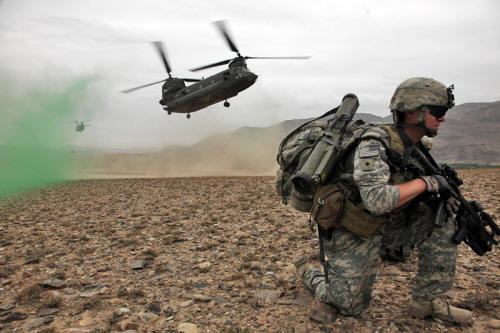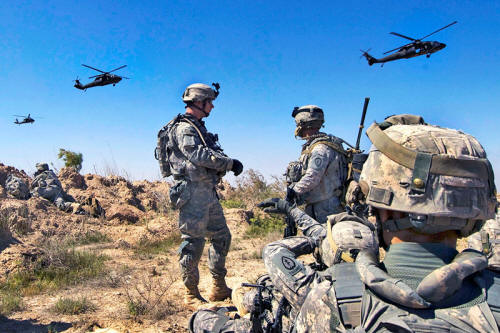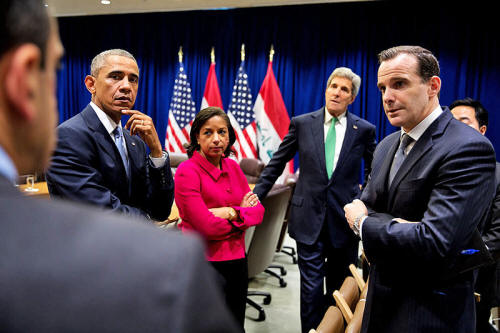|
from ShadowProof Website
(Released) President Barack Obama declared during his second inauguration speech,
However, one of the main legacies of
Obama's presidency may be that his administration further
institutionalized a framework for a global "war on terrorism" with
no end in sight.
There are six "theaters" of war, which the report highlights:
It omits Pakistan, where the CIA has launched drone strikes, as well as countries in Africa, like Mali.
The report does not address the human cost of the global "war on terrorism."
It does not suggest whether any goals or objectives in this endless war have been achieved over the past 15 years.
Instead, with the ominous election of Donald Trump looming over the country, the report serves as a document capable of insulating the Obama administration from criticism that officials may have gone too far in expanding the presidential power to wage war and carry out "national security operations."
The track record of the U.S. in "theaters" of war is to pursue war policies, which aid in destabilization and spur the rise of extremist groups that become enemies of the U.S.
These enemies provide the U.S. justification for expanded war efforts and touch off a deadly cycle that guarantees countries transform into failed states that may never be hospitable for humanity ever again.
Obama Backtracked On Pledge To Bring Afghanistan War To End
The war in Afghanistan was launched in 2001, as an act of retaliation for the September 11th attacks.
As of August 2016, according to the "Costs of War Project" at the Watson Institute of International and Public Affairs at Brown University, at least 31,000 Afghan civilians have been killed in Afghanistan. Well over 40,000 Afghan civilians have been "seriously injured" since January 2009.
The International Committee of the Red Cross had 9,200 new patients in 2015, and 1,261 were amputees.
It was estimated, as of June 2016, that there were 1.4 million refugees inside Afghanistan and "nearly 1 million Afghans were internally displaced." At least 2.6. million Afghans are refugees in over 70 countries.
Obama pledged to withdraw troops and bring the occupation closer to an end, but in July, he announced 8,400 U.S. troops would remain in Afghanistan.
The percentage of civilians in Afghanistan killed by "pro-government forces," according to the United Nations Assistance Mission in Afghanistan (UNAMA), has risen dramatically.
Deaths of children continue to escalate since 2013, with 639 deaths and 1,822 injuries documented. The rate of civilian deaths from air strikes has also skyrocketed in the past two years.
Yet, no matter how long war continues to destroy the lives of Afghans, they can take solace in the fact that Obama made sure it is all supposedly being carried out according to U.S. law and international law.
The report is largely free of historical context. It indicates the U.S. is,
The U.S. is,
Entire Iraqi Cities No Longer Exist
To large extent, war has plagued Iraq since the Persian Gulf War in 1990, which was launched after Iraq President Saddam Hussein was no longer a tyrant America was willing to keep as an ally.
The war based on lies launched by President George W. Bush's administration in March 2003 merely added to the prior decade's record of destruction. Out of the rubble of the U.S. invasion and in the prisons, where U.S. forces tortured detainees, the Islamic State was essentially born.
The "Iraq Body Count Project" estimates 168,000-187,000 civilians have died as a result of violence in Iraq since the 2003 invasion. More than 16,000 civilians have died in Iraq since March 2015.
According to the "Costs of War Project," before fighting related to the Islamic State, 1.5 million Iraqis were "displaced internally or into neighboring countries."
Iraq once had one of the best health care systems in the region, but doctors fled.
The use of depleted uranium and white phosphorus by U.S. forces has resulted in a staggering increase in the rates of cancer and birth defects.
As journalist Dahr Jamail reported, congenital malformations in Fallujah outpace the rate of malformations seen in Hiroshima and Nagasaki after the U.S. dropped nuclear bombs.
Journalist Anand Gopal has reported on entire cities in Iraq that have been flattened in the war against the Islamic State.
He said Ramadi looks "post-apocalyptic." The city essentially does not exist anymore. And what has unfolded in the past few years is the end of Sunni Iraq, which is "very bleak."
However, Obama has reassured the world that the "use of force" is being carried out in complete accordance with U.S. law and international law. Iraqis may be caught between the dark menace that is the Islamic State and the forces of U.S. empire, but certainly, they must find this reassuring.
In Syria, the U.S. is carrying out strikes against Islamic State forces.
There are also,
DoD photo by Mass Communication Specialist 2nd Class Walter J. Pels.
Pouring Gasoline On The Flames Of War In Syria
This is newer terminology for the Obama administration so it is unclear what groups qualify as "indigenous ground forces."
But the U.S. has employed a policy of arming "rebel groups" that has not gone well.
The New York Times reported in June,
Militias armed by the Pentagon have fought brigades armed by the CIA.
A report from Amnesty released about one year ago showed a lot of the Islamic State's equipment and weapons came from stockpiles that the group captured from the Iraqi military and Syrian opposition forces.
As CIA and Pentagon weaponry changes hands in Syria, the Syrian Observatory for Human Rights reported over 86,000 civilians have died since March 18, 2011. At least 15,000 of those killed were children.
The United Nations High Commissioner for Refugees (UNHCR) estimates 4.8 million people have fled Syria to,
...since 2011, and 6.6 million people are "internally displaced within Syria."
(Note: Syrians who fled to Iraq have faced the predicament of having to flee to another country because of violence in Iraq.)
There are over a dozen countries supporting Syrian government forces and Syrian opposition forces so not all of the carnage can be solely attributed to the actions of the United States.
On the other hand, the policy seems akin to putting out a fire with gasoline. For example, the CIA has supported groups like Ahrar al Sham, which committed a massacre in Latakia in 2013.
Nonetheless, the Obama administration maintains it has followed the law by only providing "assistance" to Syrian groups and individuals appropriately vetted for ties to terrorist organizations.
A Fresh Cycle Of War In Somalia
The Obama administration, which has fought al Shabab in Somalia throughout the past years, freshly claims it has ties to al Qaida and so it is completely legal to wage war in the country.
Though, as journalist Jeremy Scahill detailed in his book, "Dirty Wars - The World Is A Battlefield," CIA-backed Somali warlords were defeated by the Islamic Courts Union in the mid-2000s, and blowback from U.S. policies in Somalia, as well as abroad, inspired al Qaida.
In 2007, it was reported that the U.S. poured weapons and military advisers into the Christian-led nation of Ethiopia to support a new front in the "war on terrorism."
Ethiopian forces invaded Somalia and helped overthrow a fundamentalist Islamic government. That invasion destabilized the country and gave Shabab an enemy critical to expanding its presence in Somalia.
Americans are very familiar with the Battle of Mogadishu in 1993, which NPR characterizes as the,
That Somalia has effectively been without a government since 1991 is far, far, far more unknown.
And what of the death toll over the past 25 years?
Agence France Presse put the death toll from war in Somalia at about 500,000 in 2006. Ten years later, it is fair to say the extent of casualties is unknown (and fairly unimportant to the world's most powerful countries).
The UNHCR estimated in 2015 that 1.1 million refugees have fled Somalia.
In fact, a stark reality is that,
All of these are "theaters," where the war machine of the United States has regularly showcased its strength during Obama's tenure.
Libya - Redefining What It Means to Go to "War"
To deploy military forces in Libya, Obama flouted the War Powers Act and launched a war against Muammar Gaddafi's regime without the approval of Congress.
He disregarded advice from the Justice Department and relied upon his White House counsel to set a precedent that future presidents like Trump would be able to call upon to start new wars without Congress's support.
It may be fair to say the Obama administration has redefined what it means to go to "war."
The Justice Department's Office of Legal Counsel apparently contends,
So, if the U.S. is only planning a quick foray into another country that is "targeted," the president can wage whatever amount of war he or she sees fit to unleash.
Around five years later, as journalist Vijay Prashad reported, the United States has bombed Sirte about 490 times in order to wrest the city from Islamic State control.
The U.S. government was not fighting the Islamic State in 2011, however, the Obama administration insists this was all legal.
More importantly, through his work, Prashad has repeatedly highlighted the many ways in which the state of Libya was completely and utterly destroyed. The overthrow of Gaddafi's regime gave a number of extremist militia groups opportunity to seize control of regions of Libya and fight for power.
Thousands of civilians have died in Libya since 2011.
While difficult to find numbers for how many Libyans have fled the war, Le Monde reported somewhere between 600,000 to 1 million refugees left for Tunisia. Tens of thousands of refugees from Libya have attempted dangerous treks across the Mediterranean Sea to get to Italy.
Nearly 160,000 people have arrived in Italy in 2016.
In 2014, about 170,000 fled to Italy. The number of refugees since the war in Libya started is easily in the millions. But while Libya may have transformed into a failed state lost to extremist militias for the next couple of decades, take comfort, Libyans.
President Obama says war is being fought according to U.S. law and international law.
Official White House Photo by Pete Souza
With U.S. Support, Saudi-Led Coalition Utterly Destroyed Schools, Homes, and Hospitals In Yemen
The Obama administration contends it has,
While the U.S. is not engaged in the same extent of warfare as military forces are in Iraq, the U.S. provides "logistical support," like "air-to-air refueling."
It shares intelligence with the coalition led by Saudi Arabia. It offers military advice on "best practices" for reducing civilian casualties and how to comply with the "law of armed conflict."
What the Obama administration has done over the past year and a half is give the Saudi-led coalition cover to decimate schools, homes, hospitals, and areas of commerce in Yemen, which was already one of the poorest countries in the world.
In October, 140 mourners were killed in an airstrike on a funeral in Sanaa, Yemen.
The coalition has attacked hospitals run by Doctors Without Borders and killed people receiving treatment. This bombardment spurred the aid organization to withdraw from six hospitals in north Yemen.
The U.N. estimates over 4,000 civilians have been killed, and their deaths have directly benefited al Qaida and Islamic State forces in Yemen.
Paul Gottinger and Ken Klippenstein reported for Shadowproof,
Weapons like white phosphorus and cluster bombs are shipped from the U.S. and fired against the civilian population of Yemen in a kind of proxy war against Iran.
U.S. diplomatic cables disclosed by U.S. Army whistleblower Chelsea Manning showed the Obama administration was once reticent to provide arms for Saudi Arabia or Yemen if the weapons were going to be used against Houthi separatists.
The Obama administration has shed this stipulation and allowed the U.S. to fully back Saudi Arabia's total destruction of entire areas of Yemen.
UNHCR estimates at least 180,000 Yemeni refugees have fled the country as a result of the U.S.-backed war by the Saudi-led coalition.
The Obama administration acknowledges,
Somehow, the administration still expects the world to imagine there will be a day when the U.S. government will end this war, a prospect that seems highly unlikely given the fact that any end to warfare could easily be spun by extremist forces and purveyors of violence in the military industrial-complex as an act of surrender.
What is evident is the Obama administration has firmly entrenched the U.S. in a global perpetual war against a mode of violence employed by individuals, who lack a monopoly of violence over the instruments of state governments.
Even more so than President George W. Bush, he made it so this "war on terrorism" could endure for decades and continue without Congress having to provide any further consent for war.
U.S. warfare begets a record number of refugees.
Hundreds of thousands of refugees clamor for a life in America, but the government and its citizens largely resent the idea of having to provide them a safe home, even though their country's actions are responsible for their current despair...
|




